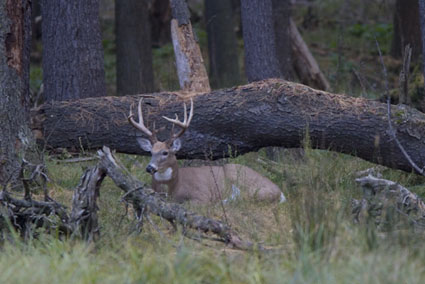 Deer bed down wherever they can find concealment, often among brush, blow-downs, and rotting logs. |
Bucks learn early in their lives that they must seek shelter where they can avoid predators, especially the two-legged variety. That usually means bedding down alone either in the thickest cover available or near the top of the highest peaks.
However, bucks do grow old by laying low in areas many hunters dismiss as good cover. Over the last four decades I have been amazed at the lengths bucks will go to keep out of harm’s way. Some of these sites I stumbled upon during the open season while others were located by backtracking an evening buck trail in fresh snow.
Blow-Downs
The crisscrossed branches and dead leaves offer a resting buck ample cover. Just as importantly they also allow him to twist his head and neck to see all around him without divulging his whereabouts. Crawl inside, and you will see what I mean.
Brush Dumps
Bucks do not always travel far to bed down. In fact, they sometimes seek refuge in the piles of brush and debris adjacent to farm fields. One day I kicked two P&Y animals out of a log jam created by a bulldozer clearing hedge rows. They both felt secure not 10 feet off the edge of a cut corn lot.
Rotting Logs
Dead logs three or four feet in diameter are ideal buck bedding sites. And for good reason. The log conceals much of their body while the brown bark matches the deer’s hide, offering perfect camouflage from almost any angle of approach.
Backyard Bungalow
Bucks will sometimes avoid hunting pressure by bedding down within a few yards of house, and they will stay there as long as the occupants remain inside. I have even seen evidence in the snow where a buck bedded down adjacent to a pair of ornamental cedars with his back up against the cement foundation!
Rusting Farm Implements
Most farms have a graveyard for old corn harvesters and broken-down wheel harrows. Part of the reason bucks bed nearby may be the fact that stinky humans consistently shy away from these old relics.
Highway Medians
One of the safest places for a big buck during the deer season is on the median between two interstate highways. Although traffic noises can interfere with a buck’s hearing, they don’t seem to mind as long as you don’t stop to gawk at them.
Lone Ranger
One of the most unlikely sites of refuge is a single tree growing in the wide open spaces, such as a cut corn lot or open pasture. The main draw is that the tree serves as a navigational landmark. It is also a good place to watch for does.
Stone Walls
Bucks often take refuge behind a wall of stones created years earlier when a nearby field was cleared for planting. Look for bucks to be resting near any breaks in the wall.
Finally, when you are looking for a bedded buck, key in on his black nose, white muzzle and eye rings, and throat patch. A twitch of an ear or a rotating rack is also a dead giveaway.






